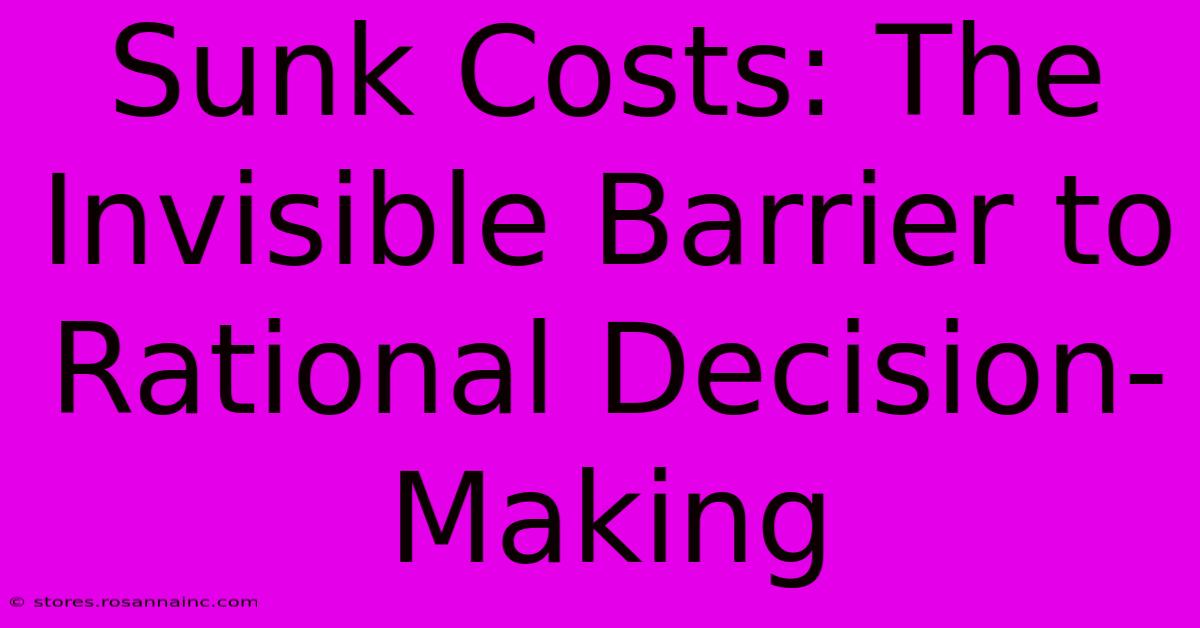Sunk Costs: The Invisible Barrier To Rational Decision-Making

Table of Contents
Sunk Costs: The Invisible Barrier to Rational Decision-Making
We've all been there. Stuck in a situation, pouring more resources into something that's clearly not working, all because of the time and money already invested. This is the insidious trap of sunk costs – a powerful cognitive bias that hinders rational decision-making. Understanding sunk costs and how they influence our choices is crucial for both personal and professional success.
What are Sunk Costs?
Sunk costs are past investments of time, money, or effort that are irretrievable. They're essentially costs that have already been incurred and cannot be recovered, regardless of future decisions. This seemingly simple definition holds profound implications for our choices. Think of it this way: Once a cost is sunk, it's irrelevant to future decisions. Yet, our brains often fail to grasp this fundamental principle.
Examples of Sunk Costs in Everyday Life:
- A failing business: An entrepreneur continues to invest in a struggling business, hoping to recoup losses, even when evidence suggests it's beyond saving. The sunk cost (initial investment, time spent) clouds their judgment.
- A disappointing movie: You're watching a terrible movie you paid for. You persevere, even though you're bored, because you "already paid for it." The ticket price is a sunk cost.
- A relationship gone sour: You stay in a toxic relationship because you've invested so much time and emotion. The past investment makes it hard to walk away.
The Psychology Behind Sunk Costs
Our reluctance to abandon a failing venture, despite the evidence, stems from several psychological factors:
- Loss aversion: We feel the pain of a loss more strongly than the pleasure of an equivalent gain. Giving up on a project feels like acknowledging a loss, a painful experience we try to avoid.
- Confirmation bias: We tend to seek out information confirming our existing beliefs. If we've already invested heavily in something, we're more likely to find reasons to justify continuing, ignoring contradictory evidence.
- Cognitive dissonance: Continuing to invest in something that's not working creates cognitive dissonance—a mental discomfort caused by holding conflicting beliefs. To reduce this discomfort, we often rationalize our actions, making it harder to cut our losses.
Overcoming the Sunk Cost Fallacy
Recognizing the sunk cost fallacy is the first step toward overcoming it. Here are some practical strategies:
1. Focus on Future Outcomes:
Instead of dwelling on past investments, concentrate on the potential future costs and benefits of different options. What is the best course of action from this point forward, regardless of what happened before?
2. Seek Objective Feedback:
Obtain impartial opinions from trusted sources. An objective perspective can help you separate your emotional attachment from the rational evaluation of the situation.
3. Set Clear Exit Strategies:
Establish predetermined criteria for abandoning a project or investment. Define specific thresholds for losses or lack of progress that will trigger a reassessment and potential exit.
4. Practice Mindfulness:
Be aware of your emotional responses and how they might be influencing your decisions. Mindfulness can help you distance yourself from emotional biases and make more rational choices.
Sunk Costs in Business Decisions
The sunk cost fallacy can be particularly detrimental in business. Sticking with a failing product, a losing marketing campaign, or an underperforming employee due to prior investment can severely impact profitability and long-term success.
Minimizing Sunk Costs in Business:
- Regular performance reviews: Continuously assess projects and investments, using clear metrics to identify underperformance early on.
- Agile methodologies: Employ flexible project management approaches that allow for course correction and the abandonment of failing aspects without significant loss.
- A culture of learning from failures: Encourage a workplace environment where acknowledging and learning from past mistakes is valued over clinging to past investments.
Conclusion: Making Rational Choices
The sunk cost fallacy is a pervasive cognitive bias that significantly impacts our decision-making. By understanding its underlying mechanisms and implementing practical strategies to mitigate its effects, we can make more rational choices, both personally and professionally, leading to better outcomes and greater success. The key is to focus on future value, not past investments. Let go of what's gone and embrace what's possible.

Thank you for visiting our website wich cover about Sunk Costs: The Invisible Barrier To Rational Decision-Making. We hope the information provided has been useful to you. Feel free to contact us if you have any questions or need further assistance. See you next time and dont miss to bookmark.
Featured Posts
-
Hyacinth Haven Fragrant Blooms To Create A Garden Of Love For Mom
Feb 04, 2025
-
Coupon Magic Transform Your Shopping Into A Glamourous Affair
Feb 04, 2025
-
Mountain West Explosion Reasons You Wont Believe
Feb 04, 2025
-
Embrace Abundance And Prosperity New Year Cards To Attract Good Fortune And Success
Feb 04, 2025
-
L Evolution Du Logo De Louis Vuitton Un Voyage A Travers Le Temps
Feb 04, 2025
